Kingdom Animalia Order Rhinopristiformes Higher classification Pristiformes Phylum Chordata | Superorder Batoidea Scientific name Pristidae Rank Family Subclass Elasmobranchii | |
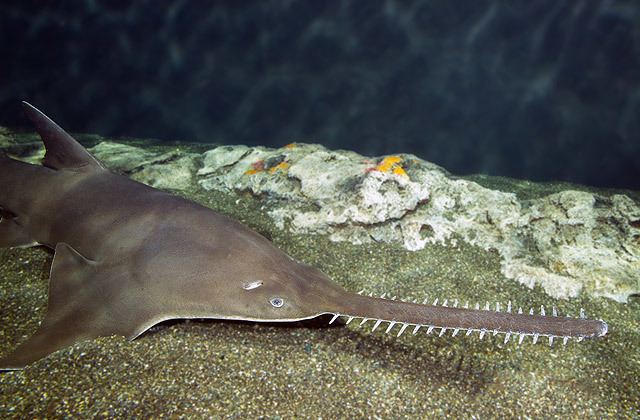 | ||
Lower classifications Largetooth sawfish, Smalltooth sawfish, Pristis | ||
Sawfishes, also known as carpenter sharks, are a family of rays characterized by a long, narrow, flattened rostrum, or nose extension, lined with sharp transverse teeth, arranged so as to resemble a saw. Several species of sawfishes can grow to about 7 m (23 ft). The family as a whole is largely unknown and little studied. The Pristidae are the only living family within the order Pristiformes, whose name comes from the Ancient Greek: πρίστης prístēs "saw, sawyer".
Contents
- How the sawfish uses its saw
- Description
- Distribution and habitat
- Behavior
- Reproduction
- Extant taxa
- Conservation
- Cultural perception
- References
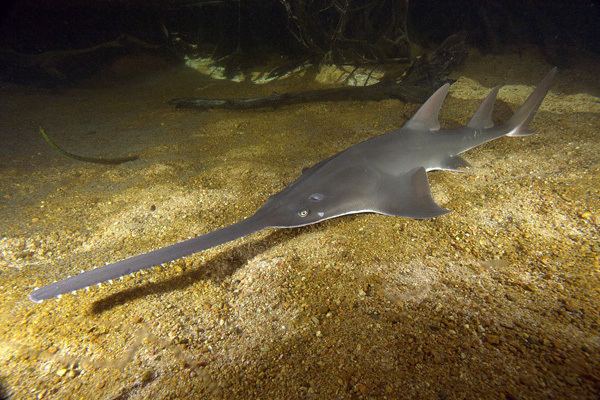
Sawfishes should not be confused with sawsharks (order Pristiophoriformes), or the extinct sclerorhynchids (order Sclerorhynchiformes) which have a similar appearance.
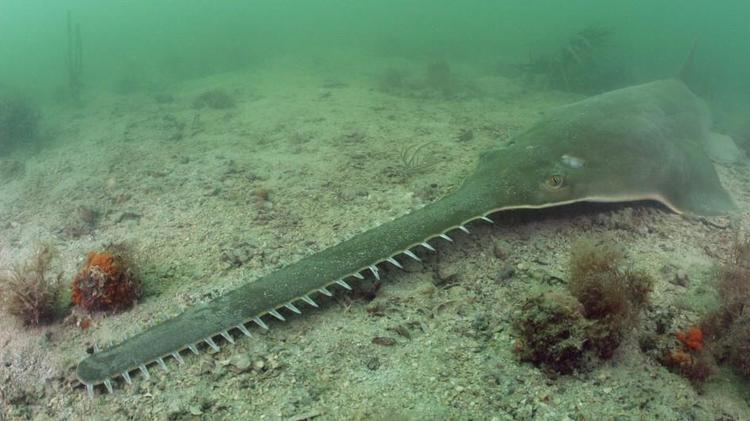
All species of sawfishes are listed as Endangered or Critically Endangered by the IUCN, and face the threat of extinction as a result of habitat loss and overfishing. Global populations of every species of sawfishes are estimated to have fallen to less than 10% of their historic levels, and they have been lost from at least 80% of their historic range. The smalltooth sawfish (Pristis pectinata), for example, was once widely distributed, but available data indicate the range of this species has been reduced by about 90%, and population numbers have declined dramatically, perhaps by 95% or more. International commerce of sawfishes has been banned globally since 2007, with the only exception being for the provision of live Pristis microdon to appropriate public aquaria for primarily conservation purposes.
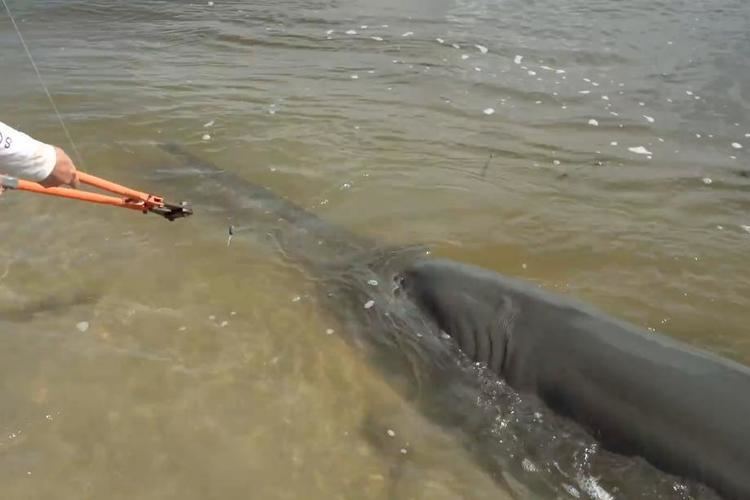
How the sawfish uses its saw
Description
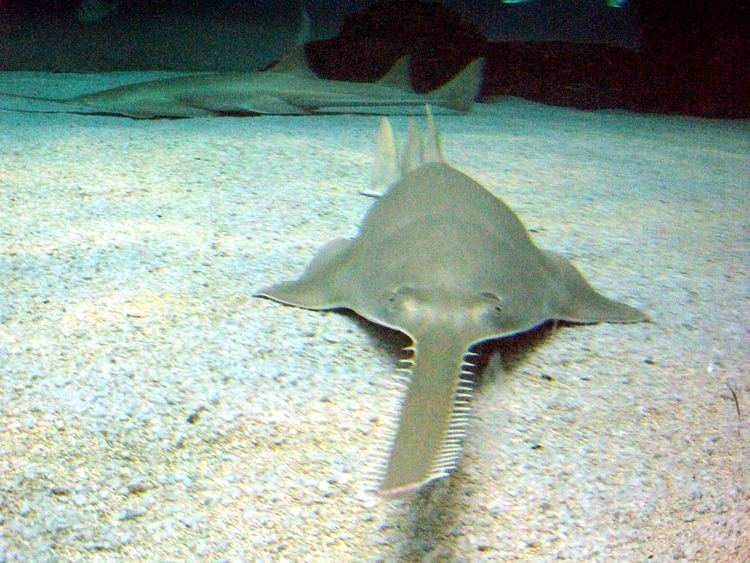
The sawfish's most distinctive feature is the saw-like rostrum, covered with electrosensitive pores that allow the sawfish to detect slight movements of prey hiding in the muddy sea floor. The rostrum also serves as a digging tool to unearth buried crustaceans. Should suitable prey try to swim past, the normally lethargic sawfish springs from the bottom and slashes at it with its saw. This generally stuns or impales the prey sufficiently for the sawfish to devour it. Sawfish also defend themselves with their rostrum against intruding divers and predators such as sharks. The "teeth" protruding from the rostrum are not real teeth, but modified tooth-like structures called denticles.

The body and head of a sawfish are flat, and they spend most of their time lying on the sea floor. Like rays, a sawfish's mouth and nostrils are on its flat underside. The mouth is lined with small, dome-shaped teeth for eating small fish and crustaceans, which the fish sometimes swallows whole. Sawfish breathe with two spiracles just behind the eyes that draw water to the gills. The skin is covered with tiny dermal denticles that give the fish a rough texture. Sawfish are usually light grey or brown; the smalltooth sawfish, Pristis pectinata, appears olive green.
Like other elasmobranchs, sawfish lack a swim bladder and use a large, oil-filled liver to control buoyancy. Their skeleton is made of cartilage.
The eyes of the sawfish are underdeveloped due to their muddy habitats. The rostrum is the main sensory device.
Their small intestines contain an internal partition shaped like a corkscrew, called a spiral valve, which increases the surface area available for food absorption.
The smallest sawfish is the dwarf sawfish (P. clavata), which grows to 1.4 m (4.6 ft), much smaller than the others. The largest species seem to be the large-tooth sawfish (P. microdon), the Leichhardt's sawfish (P. perotteti), and the common sawfish (P. pristis), which can all reach about 7 m (23 ft) in length. One southern sawfish was recorded as weighing 2,455 kg (5,412 lb). Such massive specimens that survive long enough to approach their maximum size and age are believed to have lifespans of about 51 years.
Distribution and habitat
Sawfishes are marine, euryhaline (moving between freshwater and saltwater), or marginal (brackish water) species, and are widely distributed across tropical and warm temperate nearshore ocean waters in the Atlantic and Indo-Pacific. They inhabit inshore coastal areas such as coastal lagoons, estuarine environments, and the lower, brackish river deltas. Some species are known to penetrate far into rivers and major lakes such as Lake Nicaragua.
Though few details of their ecology are precisely known, sawfishes tend to prefer shallow, muddy, brackish water, spending most of their time on or near the seabed, only visiting the surface occasionally. Juveniles are common in very shallow waters, and adults can be found at depths of 40 m (130 ft) or more.
Sawfishes have declined drastically and few records are recent in several regions. For example, sawfishes were once relatively common in the northeast Atlantic off West Africa, but few recent sightings are reported.
Behavior
Sawfishes are nocturnal, usually sleeping during the day and hunting at night. Despite their fearsome appearance, they do not attack people unless provoked or surprised. The small-tooth sawfish is well known by fishermen as a prize game fish because of the fight it puts up once hooked.
Reproduction
Little is known about the reproductive habits of the sawfish. They are estimated to mate once every two years, with an average litter of around eight. They mature very slowly: it is estimated that the larger species do not reach sexual maturity until they are 3.5 to 4 m (11 to 13 ft) long and 10 to 12 years old. Their reproduction rates, lower than that of most fish, make these animals especially slow to recover from overfishing.
Females are ovoviviparous, bearing live pups, whose rostral blades are soft and flexible during embryonic development, with teeth that are enclosed by a sheath – so as to protect the mother during the birthing process. The sheath eventually disintegrates and falls off.
Extant taxa
The taxonomy of the sawfish family Pristidae has been described as chaotic, with uncertainty as to the true number of valid species. It contains two genera grouped by similar visual characteristics. The genus Anoxypristis contains one species (A. cuspidata) and the genus Pristis contains from four to six species. Pristis has been divided into two groups, commonly referred to as smalltooths and largetooths.
Conservation
All species of sawfishes are listed as critically endangered or endangered, and risk extinction, as their populations have declined to less than 10% of historical levels – the result of habitat destruction and overfishing. The smalltooth sawfish (P. pectinata), for example, was once widely distributed in parts of the Atlantic Ocean, Gulf of Mexico, Mediterranean Sea, Black Sea and Indo-Pacific. Available data indicate the range of this species has been reduced by about 90%. As a result, surviving local subpopulations have become severely fragmented. Population numbers of this species are estimated at less than 5% to perhaps as low as 1% of their historic levels.
While sawfishes are accidentally caught as bycatch in fishing nets – due to their easily entangled rostra – they are also exploited for their rostra (prized as a curiosity by some), their fins (eaten as a delicacy by others), and their liver oil (used in folk medicine). The rostrum can reportedly fetch prices of over US$1,000 (£500) apiece in some markets. While arguing for a global ban on international commerce in 2007, a representative from the National Museums of Kenya stated, "Only the meat is consumed locally; and artisanal fishermen can retire after catching one sawfish due to the high value of a single rostrum, up to $1,450."
While fins from many shark species are used in the trade, certain shark species have been identified over the centuries as supplying the tastiest and most succulent fins. The shark-like rays (the sawfishes and shovelnose rays) supply the highest quality fin. As observed by one of the leading treatises on shark trade, "The ... fins ... from the white-spotted guitarfish [Rhynchobatus spp.] are considered to be most valuable. The preferred shark species for fins are tiger, mako, sawfish, sandbar, bull, hammerhead, blacktip, porbeagle, thresher and blue shark." The fins from the critically endangered sawfishes "are highly favored in Asian markets and are some of the most valuable shark fins." Sawfishes are now protected under the highest protection level of the Convention on International Trade in Endangered Species (CITES), Appendix I, but given the great volume of the shark fin trade, and that detached shark fins are difficult to identify, it is unlikely that CITES protection will prevent sawfish fins from entering the trade.
Capturing a sawfish is illegal in certain countries like the United States and Australia. The sale of smalltooth sawfish rostra is prohibited in the United States under the Endangered Species Act. Additionally, A. cuspidata, P. clavata, P. microdon, and P. zijsron are listed as candidates under that act. Since 2007, the import for sale of that of any sawfish species is also prohibited.
While popular in public aquaria, sawfishes are difficult to maintain because of their size. They likely require a variety of habitats, including both marine and fresh water to complete their lifecycles. Consequently, captive breeding has resulted in very little success, so far limited to a single species (P. pectinata) at a single aquarium (Atlantis Paradise Island).
The international trade of sawfish was banned by the CITES convention in June 2007. At the 14th CITES Conference, the Australian delegation proposed an annotation to all species from the family Pristidae to Appendix I. The annotation was supported by the required two-thirds majority, and allowed P. microdon to be treated as Appendix II “for the exclusive purpose of allowing international trade in live animals to appropriate and acceptable aquaria for primarily conservation purposes.” The annotation was accepted on the basis that Australian populations of P. microdon are robust relative to other populations in the species' range; and that the capture of individuals for aquaria is likely to be detrimental to the population in any other country than Australia. All trade must be accompanied by an agreement between the exporter, importer, and the Australian CITES Management Authority ensuring that the receiving aquarium has the capacity to house and care for the animal and that display is accompanied by comprehensive educational material. Since the implementation of the annotation, a sawfish research association has been established in northern Australia to facilitate accelerated research effort in P. microdon and other euryhaline elasmobranchs in rivers that drain to the Gulf of Carpentaria.
Cultural perception
Sawfish are a powerful symbol in many cultures. The Aztecs revered sawfish as an "earth monster". Its rostrum is used by some Asian shamans for exorcisms and other ceremonies to repel demons and disease, which has contributed to its decline. The sawfish also notably served as the emblem of the German submarine U-96 (1940), known for its portrayal in Das Boot, and was later the symbol of the 9th U-Boat Flotilla. The German World War II Kampfabzeichen der Kleinkampfverbände (Battle Badge of Small Combat Units) depicted a sawfish. These units used midget submarines, manned torpedoes, and explosive boats.
In cartoons and humorous popular culture, the sawfish—particularly its nose—has been employed as a sort of living tool. Examples of this can be found in Vicke Viking and Fighting Fantasy volume "Demons of the Deep".
A stylized sawfish was chosen by the The Central Bank of the West African States (BCEAO) to appear on coins and banknotes of the CFA currency. This was due to the mythological value representing fecundity and prosperity. The image takes its form from an Akan and Baoule bronze weight used for exchanges in the commercial trade of gold powder.
